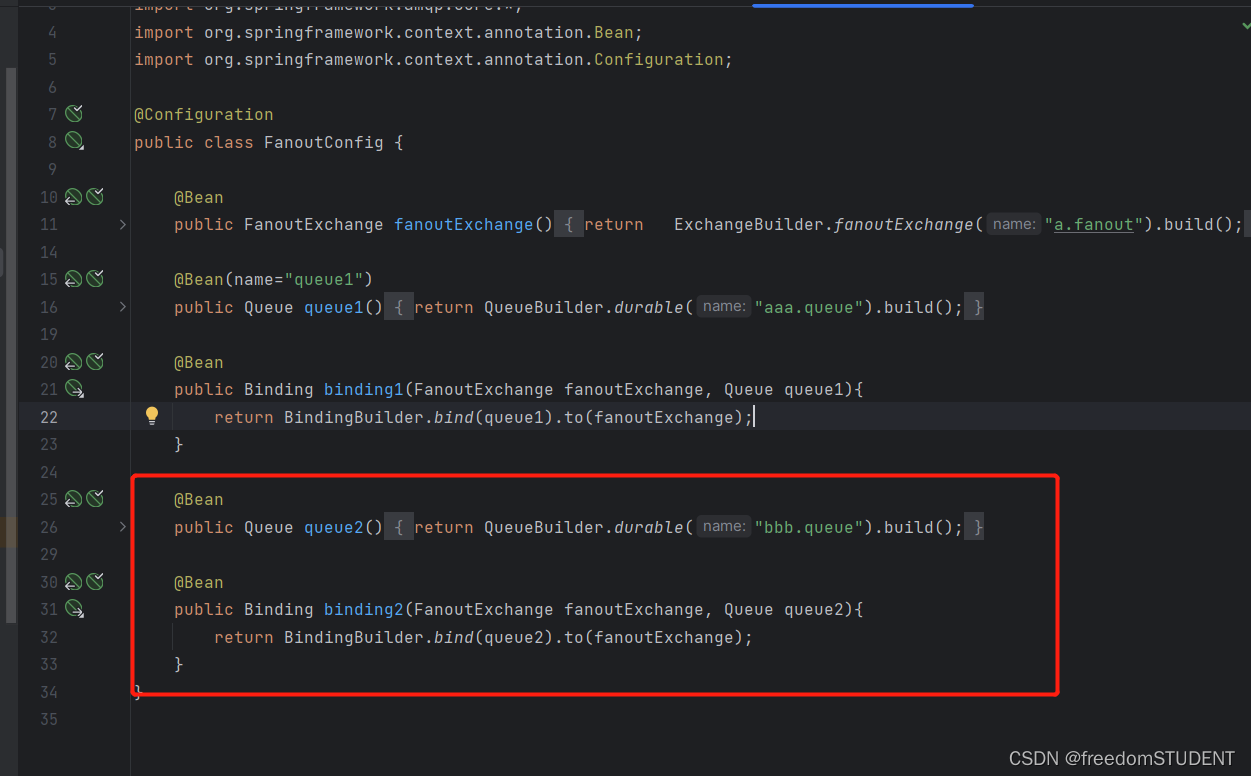上一篇:springboot整合rabbitMQ模拟简单收发消息
https://blog.csdn.net/m0_67930426/article/details/134904766?spm=1001.2014.3001.5501
相关配置环境参考上篇
springAMQP提供了几个类用来声明声明队列,交换机及其绑定关系
声明队列,交换机及其绑定都在消费者一端完成
目录
基于Bean声明
Fanout
声明交换机
声明队列
交换机绑定队列
Direct
声明交换机
声明队列
交换机绑定队列
基于注解声明
基于Bean声明
Fanout
声明交换机
package com.example.consumer.config;import org.springframework.amqp.core.FanoutExchange;
import org.springframework.context.annotation.Bean;
import org.springframework.context.annotation.Configuration;@Configuration
public class FanoutConfig {@Beanpublic FanoutExchange fanoutExchange(){return new FanoutExchange("a.fanout");}}
另一种写法
@Beanpublic FanoutExchange fanoutExchange(){return ExchangeBuilder.fanoutExchange("a.fanout").build();}
声明队列
@Beanpublic Queue queue1(){return new Queue("aaa.queue");}另一种写法
@Beanpublic Queue queue1(){return QueueBuilder.durable("aaa.queue").build();}
交换机绑定队列
@Beanpublic Binding binding1(FanoutExchange fanoutExchange, Queue queue11){return BindingBuilder.bind(queue1).to(fanoutExchange);}绑定多个对列

代码:
package com.example.consumer.config;import org.springframework.amqp.core.*;
import org.springframework.context.annotation.Bean;
import org.springframework.context.annotation.Configuration;@Configuration
public class FanoutConfig {@Beanpublic FanoutExchange fanoutExchange(){return ExchangeBuilder.fanoutExchange("a.fanout").build();}@Bean(name="queue1")public Queue queue1(){return QueueBuilder.durable("aaa.queue").build();}@Beanpublic Binding binding1(FanoutExchange fanoutExchange, Queue queue1){return BindingBuilder.bind(queue1).to(fanoutExchange);}@Beanpublic Queue queue2(){return QueueBuilder.durable("bbb.queue").build();}@Beanpublic Binding binding2(FanoutExchange fanoutExchange, Queue queue2){return BindingBuilder.bind(queue2).to(fanoutExchange);}
}Direct
声明交换机
package com.example.consumer.config;import org.springframework.amqp.core.DirectExchange;
import org.springframework.amqp.core.Queue;
import org.springframework.context.annotation.Bean;
import org.springframework.context.annotation.Configuration;@Configuration
public class DirectConfig {@Beanpublic DirectExchange directExchange(){return new DirectExchange("b.direct");}声明队列
@Beanpublic Queue queue3(){return new Queue("ccc.queue");}
交换机绑定队列
@Beanpublic Binding binding3(DirectExchange directExchange, Queue queue3){return BindingBuilder.bind(queue3).to(directExchange).with("red");}以上内容创建了一个a.fanout交换机,创建了一个b.direct交换机
创建了aaa.queue队列,bbb.queue队列,ccc.queue队列
a.fanout绑定了aaa.queue,bbb.queue两个队列,b.direct绑定了ccc.queue队列
并且Routing key: " red "
基于注解声明
在基于Bean声明中,如果要再绑定一个Routing key 需要重新创建一个bean,这样势必会麻烦很多
@RabbitListener(bindings = @QueueBinding(value =@Queue(name="eee.queue" ,durable = "true"),exchange =@Exchange(name="eee.direct",type= ExchangeTypes.DIRECT ),key = {"red","blue"}))public void ccc(String msg){System.out.println("消费者收到了eee.queue的消息:【"+msg+"】");})


)
)





----轮询获取磁力计数据)
![[网络安全]批处理(脚本)编写](http://pic.xiahunao.cn/[网络安全]批处理(脚本)编写)







